形容词原级、比较级、最高级的用法
- 格式:docx
- 大小:19.97 KB
- 文档页数:3
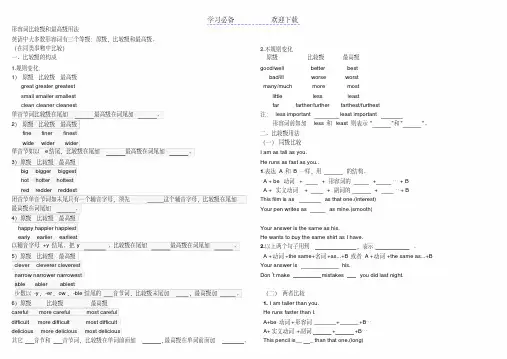
形容词比较级和最高级用法英语中大多数形容词有三个等级:原级,比较级和最高级。
(在同类事物中比较)一、比较级的构成1.规则变化:1)原级比较级最高级great greater greatestsmall smaller smallestclean cleaner cleanest单音节词比较级在尾加最高级在词尾加。
2)原级比较级最高级fine finer finestwide wider wider单音节如以e结尾,比较级在尾加最高级在词尾加。
3)原级比较级最高级big bigger biggesthot hotter hottestred redder reddest闭音节单音节词如末尾只有一个辅音字母,须先这个辅音字母,比较级在尾加最高级在词尾加。
4)原级比较级最高级happy happier happiestearly earlier earliest以辅音字母+y结尾, 把y , 比较级在尾加最高级在词尾加。
5)原级比较级最高级clever cleverer cleverestnarrow narrower narrowestable abler ablest少数以-y,-er,ow,-ble结尾的音节词,比较级末尾加,最高级加。
6)原级比较级最高级careful more careful most carefuldifficult more difficult most difficultdelicious more delicious most delicious其它音节和音节词,比较级在单词前面加,最高级在单词前面加。
2.不规则变化原级比较级最高级good/well better bestbad/ill worse worstmany/much more mostlittle less leastfar farther/further farthest/furthest注:less important least important形容词前如加less 和least 则表示" "和" "。
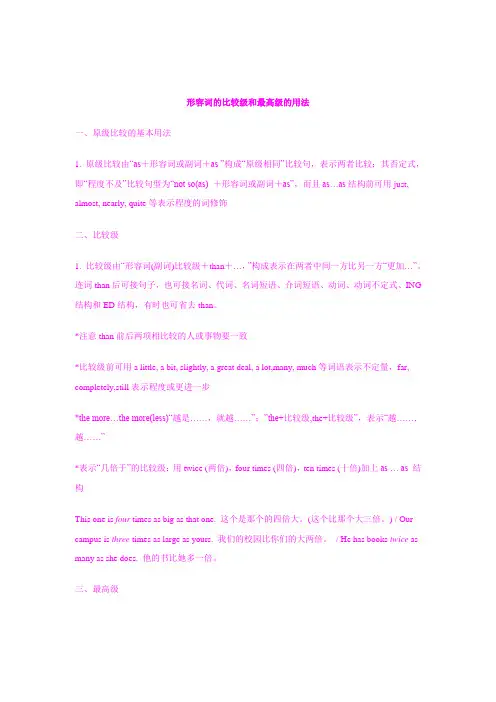
形容词的比较级和最高级的用法一、原级比较的基本用法1. 原级比较由“as+形容词或副词+as ”构成“原级相同”比较句,表示两者比较;其否定式,即“程度不及”比较句型为“not so(as) +形容词或副词+as”,而且as…as结构前可用just, almost, nearly, quite等表示程度的词修饰二、比较级1. 比较级由“形容词(副词)比较级+than+…,”构成表示在两者中间一方比另一方“更加…”。
连词than后可接句子,也可接名词、代词、名词短语、介词短语、动词、动词不定式、ING 结构和ED结构,有时也可省去than。
*注意than前后两项相比较的人或事物要一致*比较级前可用a little, a bit, slightly, a great deal, a lot,many, much等词语表示不定量,far, completely,still表示程度或更进一步*the more…the more(less)“越是……,就越……”;”the+比较级,the+比较级”,表示“越……,越……”*表示“几倍于”的比较级:用twice (两倍),four times (四倍),ten times (十倍)加上as … as 结构This one is four times as big as that one. 这个是那个的四倍大。
(这个比那个大三倍。
) / Our campus is three times as large as yours. 我们的校园比你们的大两倍。
/ He has books twice as many as she does. 他的书比她多一倍。
三、最高级1. 最高级用于三者以上比较,形容词的结构形式是“定冠词+形容词最高级+名词+表示范围的短语或从句”(如all, of all, of the three, in the world, that has ever taken place等)l 副词的最高级前可不加定冠词the*最高级在特殊短语中的使用:在有下列短语的句子中,往往使用最高级1. one of…2. of(among) all+三者以上名词或代词3. in the world(或群体名词)四、其他有关比较的习惯表达法1. “as +形容词(副词)+as possible”结构,表示“最…,尽可能…”:“as quickly as possible”(尽量快)2.“ sooner or later”,表示“迟早、早晚”完成下列句子:1.This bridge is three times as__________as that.( long)2.He is not so________ as I.( fat)3.This dog is as_________ as that.( white)4.He is___________________ than me.( handsome)5.He is __________than me.( old)6.He is_________ than any other students in the class.( tall)7.She is_______________________.(她越来越漂亮了)8.Which one is_______ ,the sandy(沙色)colour or the amber(琥珀色)colour?(good)9.This book is_________ than that one.( interesting)10.This book is_________________ of his two books.( interesting)11.____________ I'm, _____________I feel.(越忙我就越开心)12.This book is _______________ of the three.(interesting)13.Steve is ______________ of the three boys.( handsome )14.He is__________ among the three friends.( old)15. I'm ___________in my family.( tall)16. I am not __________in our class.(good)17. Which is____________ of the three watermelons?(big)18. John is ____________of the three bad boys.(bad)19. It seems that_________ of the boys are good.(many)20. Chinese is one of ____________language in the world. (good)。
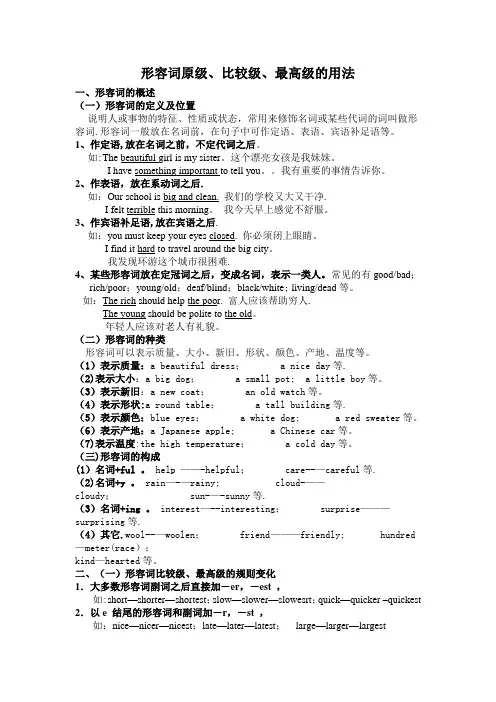
形容词原级、比较级、最高级的用法一、形容词的概述(一)形容词的定义及位置说明人或事物的特征、性质或状态,常用来修饰名词或某些代词的词叫做形容词.形容词一般放在名词前,在句子中可作定语、表语、宾语补足语等。
1、作定语,放在名词之前,不定代词之后。
如:The beautiful girl is my sister。
这个漂亮女孩是我妹妹。
I have something important to tell you。
我有重要的事情告诉你。
2、作表语,放在系动词之后.如:Our school is big and clean. 我们的学校又大又干净.I felt terrible this morning。
我今天早上感觉不舒服。
3、作宾语补足语,放在宾语之后.如:you must keep your eyes closed. 你必须闭上眼睛。
I find it hard to travel around the big city。
我发现环游这个城市很困难.4、某些形容词放在定冠词之后,变成名词,表示一类人。
常见的有good/bad;rich/poor;young/old;deaf/blind;black/white; living/dead等。
如:The rich should help the poor. 富人应该帮助穷人.The young should be polite to the old。
年轻人应该对老人有礼貌。
(二)形容词的种类形容词可以表示质量、大小、新旧、形状、颜色、产地、温度等。
(1)表示质量:a beautiful dress; a nice day等.(2)表示大小:a big dog; a small pot; a little boy等。
(3)表示新旧:a new coat; an old watch等。
(4)表示形状:a round table; a tall building等.(5)表示颜色:blue eyes; a white dog; a red sweater等。
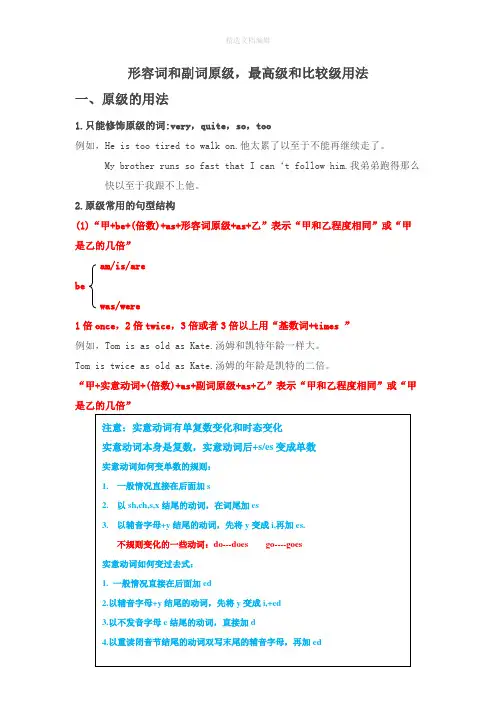
形容词和副词原级,最高级和比较级用法一、原级的用法1.只能修饰原级的词:very,quite,so,too例如,He is too tired to walk on.他太累了以至于不能再继续走了。
My brother runs so fast that I can‘t follow him.我弟弟跑得那么快以至于我跟不上他。
2.比较级常用的句型结构(1)“甲+be+(倍数)+形容词比较级+than+乙”表示“甲比乙…”或“甲比乙…几倍”例如,Tom is taller than Kate.汤姆比凯特高。
This room is three times bigger than that one.这个房间比那个大三倍。
“甲+实意动词+(倍数)+副词比较级+than+乙”表示“甲比乙…”或“甲比乙…几倍”例如,I got up earlier than my mother this morning.我今天早晨起床比我妈妈还早。
He runs three times faster than his brother.他跑的速度比他弟弟快三倍。
“甲+情态动词+实意动词原形+(倍数)+副词比较级+than+乙”表示“甲比乙…”或“甲比乙…几倍”(2)“甲+be+形容词比较级+than+any other+单数名词(+介词短语)”表示“甲比同一范围的任何一个人/物都……”,含义是“甲最……”。
(运用比较级表达最高级的句型)The Yangtze River is longer than any other river in China.=The Yangtze River is longer than any of the other rivers in China.长江比中国的任何一条其他的河都长。
=The Yangtze River is longer than the other rivers in China.长江比中国的其他所有的河都长。

小学英语语法:形容词的原级,比较级和最高级的用法以下是整理的“小学英语语法:形容词的原级,比较级和最高级的用法”内容,供大家参考学习,希望大家可以仔细阅读,若想了解更多“小学英语语法”的相关内容,可以关注,小编会持续为大家更新。
1.形容词的原级1)形容词的原级一般用在同级比较的情况较多,两个比较对象程度相同的,用“as + 形容词原级+as 的结构”Tom is as tall as his brother.汤姆和他的哥哥一样高。
My hair is as long as hers.我的头发和她的一样长。
His shoes are as new as mine.他的鞋子和我的一样新。
在这两种结构中,第一个as是副词,而第二个as 是连词,一般后面接名词、代词或所有格。
2)如果表示“……不如……”则用“not so / as +形容词原级+as的结构”His bedroom is not as big as his sister's.他的房间不如他姐姐的大。
It is not so cold as yesterday.今天不像昨天那么冷。
2. 形容词的比较级,两者比较时用形容词比较级。
1)其基本结构为“……比较级+than……”He is taller than me.他比我高。
The girl is more beautiful than before.这个女孩比以前更加漂亮了。
但我们在使用时可以加一些前置修饰词:I feel much better today. 我今天感觉好多了。
He is fat, but his brother is still fatter.他很胖,不过他哥哥更胖。
2)在两者之间选择“哪一个更……”时,用句型“Which/Who is+比较级,…or…”Which dress is cheaper, the red one or the yellow one?哪一条裙子更便宜?红的还是黄的?3)表示“两者之间较……的一个”时,用“the+比较级”Ktty is the taller of the twins.双胞胎中凯蒂比较高。
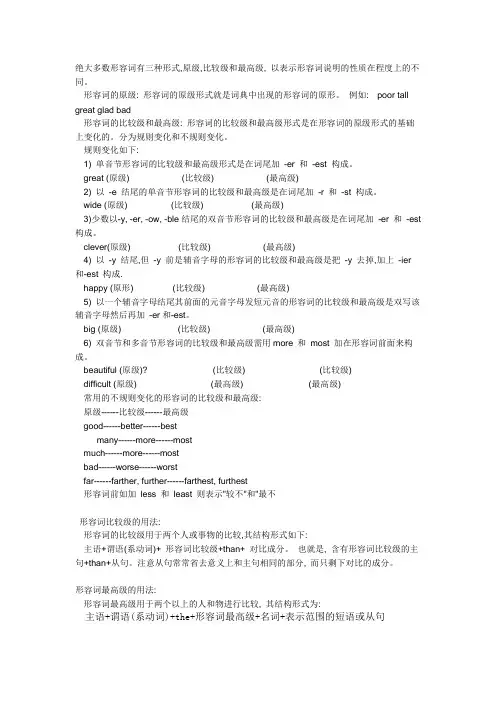
绝大多数形容词有三种形式,原级,比较级和最高级, 以表示形容词说明的性质在程度上的不同。
形容词的原级: 形容词的原级形式就是词典中出现的形容词的原形。
例如: poor tall great glad bad形容词的比较级和最高级: 形容词的比较级和最高级形式是在形容词的原级形式的基础上变化的。
分为规则变化和不规则变化。
规则变化如下:1) 单音节形容词的比较级和最高级形式是在词尾加-er 和-est 构成。
great (原级) (比较级) (最高级)2) 以-e 结尾的单音节形容词的比较级和最高级是在词尾加-r 和-st 构成。
wide (原级) (比较级) (最高级)3)少数以-y, -er, -ow, -ble结尾的双音节形容词的比较级和最高级是在词尾加-er 和-est 构成。
clever(原级) (比较级) (最高级)4) 以-y 结尾,但-y 前是辅音字母的形容词的比较级和最高级是把-y 去掉,加上-ier 和-est 构成.happy (原形) (比较级) (最高级)5) 以一个辅音字母结尾其前面的元音字母发短元音的形容词的比较级和最高级是双写该辅音字母然后再加-er和-est。
big (原级) (比较级) (最高级)6) 双音节和多音节形容词的比较级和最高级需用more 和most 加在形容词前面来构成。
beautiful (原级)? (比较级) (比较级)difficult (原级) (最高级) (最高级)常用的不规则变化的形容词的比较级和最高级:原级------比较级------最高级good------better------bestmany------more------mostmuch------more------mostbad------worse------worstfar------farther, further------farthest, furthest形容词前如加less 和least 则表示"较不"和"最不形容词比较级的用法:形容词的比较级用于两个人或事物的比较,其结构形式如下:主语+谓语(系动词)+ 形容词比较级+than+ 对比成分。
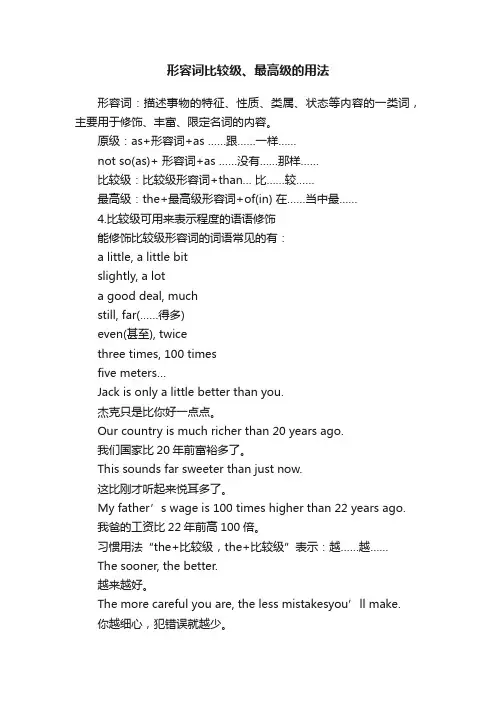
形容词比较级、最高级的用法形容词:描述事物的特征、性质、类属、状态等内容的一类词,主要用于修饰、丰富、限定名词的内容。
原级:as+形容词+as ……跟……一样……not so(as)+ 形容词+as ……没有……那样……比较级:比较级形容词+than… 比……较……最高级:the+最高级形容词+of(in) 在……当中最……4.比较级可用来表示程度的语语修饰能修饰比较级形容词的词语常见的有:a little, a little bitslightly, a lota good deal, muchstill, far(……得多)even(甚至), twicethree times, 100 timesfive meters…Jack is only a little better than you.杰克只是比你好一点点。
Our country is much richer than 20 years ago.我们国家比20年前富裕多了。
This sounds far sweeter than just now.这比刚才听起来悦耳多了。
My father’s wage is 100 times higher than 22 years ago.我爸的工资比22年前高100倍。
习惯用法“the+比较级,the+比较级”表示:越……越……The sooner, the better.越来越好。
The more careful you are, the less mistakesyou’ll make.你越细心,犯错误就越少。
The deeper the water (is),the colder it is.水越深越冷。
“比较级+and+比较级”常用来表示“越来越…”The patient is getting better and better.病人越来越好了。
Computers are cheaper and cheaper.电脑越来越便宜了。
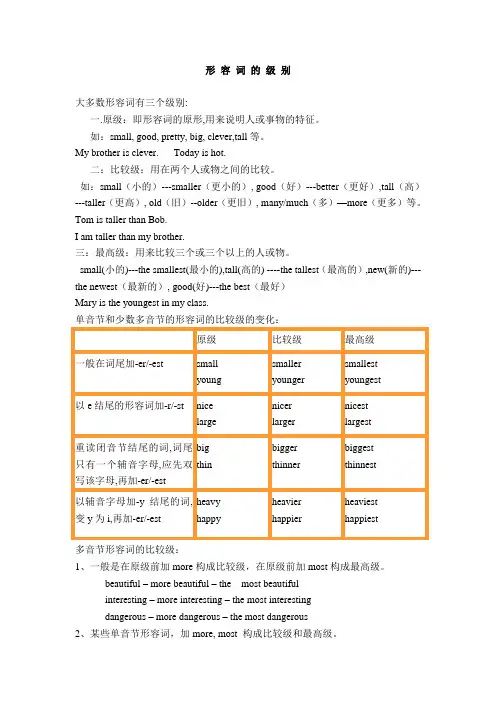
形容词的级别大多数形容词有三个级别:一.原级:即形容词的原形,用来说明人或事物的特征。
如:small, good, pretty, big, clever,tall等。
My brother is clever. Today is hot.二:比较级:用在两个人或物之间的比较。
如:small(小的)---smaller(更小的), good(好)---better(更好),tall(高)---taller(更高), old(旧)--older(更旧), many/much(多)—more(更多)等。
Tom is taller than Bob.I am taller than my brother.三:最高级:用来比较三个或三个以上的人或物。
small(小的)---the smallest(最小的),tall(高的) ----the tallest(最高的),new(新的)--- the newest(最新的), good(好)---the best(最好)Mary is the youngest in my class.单音节和少数多音节的形容词的比较级的变化:原级比较级最高级一般在词尾加-er/-est smallyoung smalleryoungersmallestyoungest以e结尾的形容词加-r/-st nicelarge nicerlargernicestlargest重读闭音节结尾的词,词尾只有一个辅音字母,应先双写该字母,再加-er/-est bigthinbiggerthinnerbiggestthinnest以辅音字母加-y结尾的词,变y为i,再加-er/-est heavyhappyheavierhappierheaviesthappiest多音节形容词的比较级:1、一般是在原级前加more构成比较级,在原级前加most构成最高级。
beautiful – more beautiful – the most beautifulinteresting – more interesting – the most interestingdangerous – more dangerous – the most dangerous2、某些单音节形容词,加more, most 构成比较级和最高级。
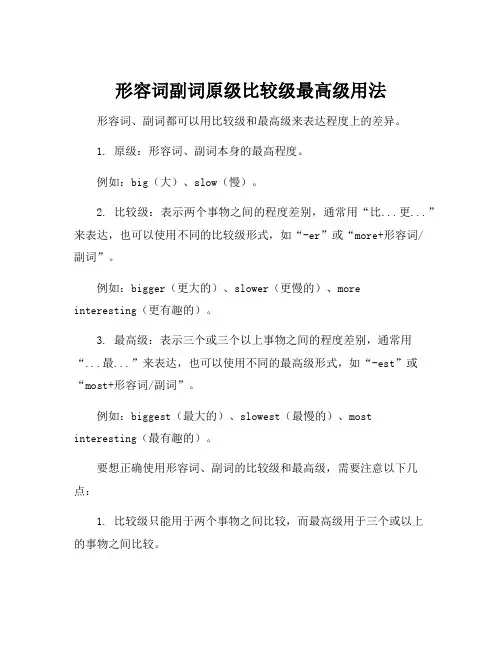
形容词副词原级比较级最高级用法形容词、副词都可以用比较级和最高级来表达程度上的差异。
1. 原级:形容词、副词本身的最高程度。
例如:big(大)、slow(慢)。
2. 比较级:表示两个事物之间的程度差别,通常用“比...更...”来表达,也可以使用不同的比较级形式,如“-er”或“more+形容词/副词”。
例如:bigger(更大的)、slower(更慢的)、moreinteresting(更有趣的)。
3. 最高级:表示三个或三个以上事物之间的程度差别,通常用“...最...”来表达,也可以使用不同的最高级形式,如“-est”或“most+形容词/副词”。
例如:biggest(最大的)、slowest(最慢的)、mostinteresting(最有趣的)。
要想正确使用形容词、副词的比较级和最高级,需要注意以下几点:1. 比较级只能用于两个事物之间比较,而最高级用于三个或以上的事物之间比较。
例如:She is taller than her sister.(她比她妹妹更高。
)/ He is the tallest in the class.(他班上最高的。
)2. 形容词、副词比较级和最高级在用法上有一些例外,如good (好)、well(好地)。
例如:good(好)--better(更好的)--best(最好的)/ well (好地)--better(更好地)--best(最好地)3. 一些形容词、副词的比较级和最高级形式是不规则的,需要记忆。
例如:good(好)--better(更好的)--best(最好的)/ bad (坏)--worse(更坏的)--worst(最坏的)/ little(小)--less (更小的)--least(最小的)。
4. 某些形容词、副词虽然有比较级和最高级形式,但在句子中不能与其它物品进行比较。
例如:unique(独一无二的)/ complete(完整的)/ excellent (卓越的)。
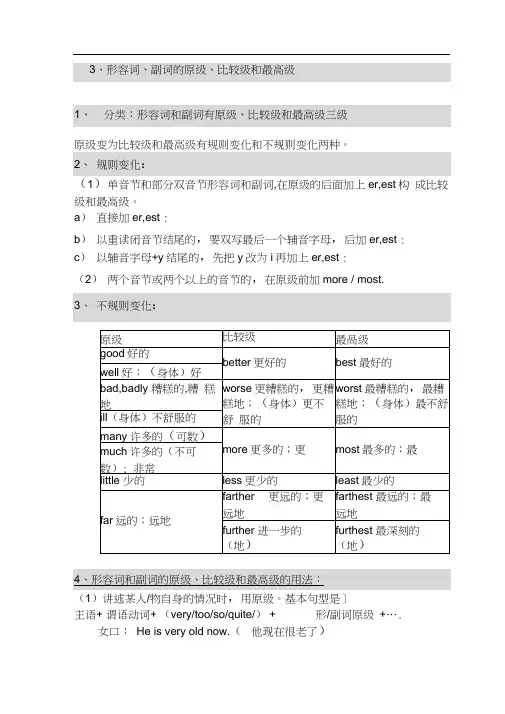
(1)单音节和部分双音节形容词和副词,在原级的后面加上er,est构成比较级和最高级。
a)直接加er,est :b)以重读闭音节结尾的,要双写最后一个辅音字母,后加er,est :c)以辅音字母+y结尾的,先把y改为i再加上er,est :(2)两个音节或两个以上的音节的,在原级前加more / most.(1)讲述某人/物自身的情况时,用原级。
基本句型是]主语+ 谓语动词+ (very/too/so/quite/) + 形/副词原级+….女口:He is very old now.(他现在很老了)They ran quite fast.(它们跑得相当快)The weather looks rather bad.(天气看上去相当糟)I am so happy!(我是如此的快乐)☆表示两者之间没有差别时, 使用句型:主语(第一个人物) + 谓语动词+ as + 形容词/副词原级+ as + 第二个人物+….如:He is as excited as his younger sister.(他和他妹妹一样兴奋)Lily rode her bike as slowly as an old lady.(莉莉骑车像老太太一样慢)They picked as many apples as the farmers (did).(他们摘的苹果和农民一样多)☆表示第一个人比不上第二个人时, 使用句型:主语(第一个人物) + 谓语动词(否定式) + as / so + 形容词/ 副词原级+ as + 第二个人物+….如:He is not so / as excited as his younger sister. (他没他妹妹那么兴奋)Lily did not ride her bike so / as slowly as an old lady.(莉莉骑车不像老太太那样慢)They didn 't pick so / as manyapples as the farmers (did).(他们摘的苹果不如农民多)(2)讲述两者有差异, 第一个人物超过第二个人物时, 用比较级。
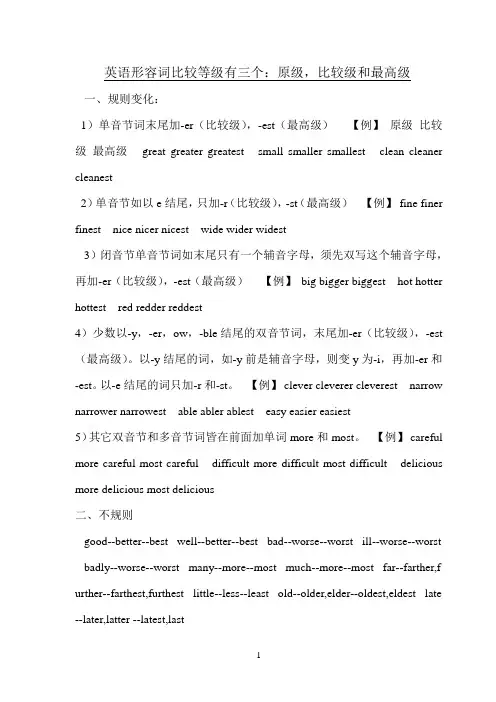
英语形容词比较等级有三个:原级,比较级和最高级一、规则变化:1)单音节词末尾加-er(比较级),-est(最高级)【例】原级比较级最高级great greater greatest small smaller smallest clean cleaner cleanest2)单音节如以e结尾,只加-r(比较级),-st(最高级)【例】fine finer finest nice nicer nicest wide wider widest3)闭音节单音节词如末尾只有一个辅音字母,须先双写这个辅音字母,再加-er(比较级),-est(最高级)【例】big bigger biggest hot hotter hottest red redder reddest4)少数以-y,-er,ow,-ble结尾的双音节词,末尾加-er(比较级),-est (最高级)。
以-y结尾的词,如-y前是辅音字母,则变y为-i,再加-er和-est。
以-e结尾的词只加-r和-st。
【例】clever cleverer cleverest narrow narrower narrowest able abler ablest easy easier easiest5)其它双音节和多音节词皆在前面加单词more和most。
【例】careful more careful most careful difficult more difficult most difficult delicious more delicious most delicious二、不规则good--better--best well--better--best bad--worse--worst ill--worse--worst badly--worse--worst many--more--most much--more--most far--farther,f urther--farthest,furthest little--less--least old--older,elder--oldest,eldest late --later,latter --latest,last三、比较级的用法1.同级比较两个比较对象程度相同时,用“as+形容词原级+as的结构”例如:Tom is as tall as his brother. My hair is as long as mine. 在这两种结构中,第一个as是副词,而第二个as是连词;在第二个as的后面接名词、句子或代词的主格(一般不要接代词的宾格)。
小学英语语法详解形容词——形容词的原级,比较级和最高级的用法一、形容词的比较级和最高级绝大多数形容词有三种形式,原级、比较级和是高级,表示形容词说明的性质在程度上的不同。
形容词的比较极和最高级形式是在形容词原级形式的基础上变化的,分为规则变化和不规则变化。
1.规则变化3) 以-y结尾,但-y前是辅音字母的形容词的比较级和最高级是把-y 去掉,加上 -ier4)以重读闭音节 + 辅音字母结尾的形容词的比较级和最高级是双写该辅音字母燃后再5)双音节和多音节形容词的比较级和最高级需用more和the most 加在形容词前面来Aaron老师的小提醒:★有些形容词的比较级和最高级,可以有两种表示法:clever—cleverer, cleverest 或者more clever, the most cleverfriendly—friendlier,friendliest 或者more friendly , the most friendly★形容词前如加less和least 则表示"较不"和"最不":important 重要,less important 较不重要,least important 最不重要。
二、形容词的原级,比较级和最高级的用法1.形容词的原级1)形容词的原级一般用在同级比较的情况较多,两个比较对象程度相同的,用“as + 形容词原级+as 的结构”Tom is as tall as his brothe.汤姆和他的哥哥一样高。
My hair is as long as hers.我的头发和她的一样长。
His shoes are as new as mine.他的鞋子和我的一样新。
在这两种结构中,第一个as是副词,而第二个as 是连词,一般后面接名词、代词或所有格。
2)如果表示“……不如……”则用“not so / as +形容词原级+as的结构”His bedroom is not as big as his sister's.他的房间不如他姐姐的大。
形容词副词比较级最高级变化规则及用法形容词的比较级和最高级的变化规则如下:1. 一般情况下,在形容词的原级后加-er作为比较级,加-est作为最高级。
例如:原级:tall(高)比较级:taller(更高)最高级:tallest(最高)2. 以字母“e”结尾的形容词,在原级后只加-r作为比较级,加-st作为最高级。
例如:原级:large(大的)比较级:larger(更大的)最高级:largest(最大的)3. 以元音字母加辅音字母结尾的单音节形容词,在原级后双写最后一个辅音字母,再加-er作为比较级,加-est作为最高级。
例如:原级:hot(热的)比较级:hotter(更热的)最高级:hottest(最热的)4. 以辅音字母加-y结尾的形容词,在原级中把-y改为-i,再加-er作为比较级,加-est作为最高级。
例如:原级:funny(有趣的)比较级:funnier(更有趣的)最高级:funniest(最有趣的)副词的比较级和最高级的变化规则如下:1. 大多数副词在前面加more形成比较级,在前面加most形成最高级。
例如:原级:quickly(快速地)比较级:more quickly(更快速地)最高级:most quickly(最快速地)2. 以字母“e”结尾的副词,在前面只加-r形成比较级,加-st形成最高级。
例如:原级:late(迟)比较级:later(更迟)最高级:latest(最迟)3. 以字母“y”结尾的副词,在前面把-y改为-i,再加-er形成比较级,加-est形成最高级。
例如:原级:busy(忙碌地)比较级:busier(更忙碌地)最高级:busiest(最忙碌地)需要注意的是,有些形容词和副词的比较级和最高级形式并不遵循以上的规则,而是需要记忆。
例如:good(好的)- better(更好的)- best(最好的), well(好地)- better(更好地)- best(最好地)。
原级比较级最高级的用法一、原级的定义和用法在英语中,形容词或副词通常有三个等级:原级(positive degree)、比较级(comparative degree)和最高级(superlative degree)。
其中,原级是形容或修饰一个单个名词或动词时的基本程度。
它没有进行任何比较,只是单纯地描述事物的状态或特征。
1. 形容词原级:例如:- This book is interesting.(这本书有趣。
)2. 副词原级:例如:- She runs fast.(她跑得快。
)二、比较级的定义和用法比较级用于表示两个人或物之间的相对程度,将两者进行了比较。
通常通过在形容词或副词前加上"-er"来构成。
1. 形容词比较级:例如:- This book is more interesting than the last one. (这本书比上一本更有趣。
)2. 副词比较级:例如:- She runs faster than her friends.(她跑得比她的朋友们快。
)三、最高级的定义和用法最高级用于表示三个或三个以上人或物之间的相对程度,将多者进行了排名并取得了最高程度。
通常通过在形容词或副词前加上"-est"来构成。
1. 形容词最高级:例如:- This book is the most interesting in the series.(这本书是这一系列中最有趣的。
)2. 副词最高级:例如:- She runs the fastest in her team.(她在团队中跑得最快。
)四、原级、比较级和最高级的修饰语除了通过形容词或副词本身的变化来表达不同等级的程度之外,还可以使用修饰语来进一步强调程度。
1. 修饰原级:例如:- John is very tall.(约翰很高。
)2. 修饰比较级:例如:- Mary is much taller than John.(玛丽比约翰高得多。
形容词:一、用法:六种1、做定语,修饰名词,放在名词前2、做表语,放在系动词之后3、做宾语补足语4、修饰不定代词,放在不定代词之后5、修饰一类人,the+形容词+动词原形6、多个形容词修饰同一个名词(限观形龄色国材)二、形容词等级(原级、比较级、最高级)1、原级公式:2个(A和B一样A不如B)A和B一样:A+be动词+as+形容词原级+as+BA不如B: A+be动词+as/so+形容词原级+as+B2、比较级公式:4个(A比B更怎样越来越怎样越….就越…. 二者中比较怎样的一个)A比B更怎样:A+be动词+比较级+than+B越来越怎样; 比较级+and+比较级越….就越….:the+比较级,the+比较级二者中比较怎样的一个:A+be动词+one of the two+名复+动单3、最高级公式:1个(A是最怎样的)A是最怎样的:A+ be动词+the+最高级+of/in+范围三、同义句转换:A+ be动词+the+最高级+of/in+范围= A+be动词+比较级+than+any other+名单+范围=A+be动词+比较级+than+the other+可复+范围= A+be动词+比较级+than+anybody/anything+else+范围四、形容词比较级和最高级的变换1、一般情况下,比较级+er 最高级+est2、以e结尾的比较级+r, 最高级+st3、辅音字母+y结尾的,变y为i后,比较级+er最高级+est4、辅音+元音+辅音结尾的,双写末尾的辅音字母后比较级+er最高级+est5、多音节和双音节词,比较级+more 最高级+most6、不规则good/well--better--best bad/badly—worse--worstmany/much—more—most little—less—leastold—older/elder—oldest/eldestfar—farther/further—farthest/furthest。
英语原级比较级最高级的用法总结在英语中,形容词和副词的原级、比较级和最高级用法非常常见。
正确运用这些级别可以使句子更加生动,丰富语言表达。
本文将总结英语中原级、比较级和最高级的用法,并提供一些例句来说明。
一、原级原级是形容词或副词的最原始、最简单的形式。
它通常用来描述一个人或物体的特征,没有进行比较。
下面是一些常见的原级用法:1. 形容词原级:- 形容词 + 名词:He is a tall man.(他是个高个子的男人。
)- 形容词 + 不可数名词:She is very smart.(她非常聪明。
)- 形容词 + 不定代词:This is a good book.(这是一本好书。
)2. 副词原级:- 副词 + 动词:He runs fast.(他跑得快。
)- 副词 + 形容词:She sings beautifully.(她唱得很美。
)- 副词 + 副词:He speaks very slowly.(他说话非常地慢。
)二、比较级比较级用于两个人或物体之间进行比较,表示程度的高低。
比较级的构成规则如下:1. 对于单音节形容词,在形容词后面加上-er:big(大)- bigger(更大)2. 对于以“e”结尾的单音节形容词,只需要在形容词后面加上-r:nice(好)- nicer(更好)3. 对于以辅音字母结尾的双音节形容词,要双写辅音字母再加上-er:thin(瘦)- thinner(更瘦)4. 对于多音节形容词,前面加上more:beautiful(美丽)- more beautiful(更美丽)下面是一些常见的比较级用法:1. 形容词比较级:- 比较级 + than + 名词:She is taller than her sister.(她比她姐姐高。
)- 比较级 + than + 不可数名词:This book is more interesting than that one.(这本书比那本书更有趣。
形容词的原级、比较级和最高级1. 原级(Positive Degree)原级是形容词的最基础形式,它形容事物的性质与特点,不具备比较关系。
通常使用 "as + adjective + as" 来构成比较。
例如:He is as tall as his father.It's as hot as the sun.She is as beautiful as a rose.Tom is as clever as Jane.比较级是形容词的一种形式,它是用来刻画两个事物的相对比较,即表示两者在某方面或者多方面上的异同。
比较级有两种表达方式:一般比较级和不规则比较级,一般比较级形式为 "adjective + er" 或者 "more + adjective" ,不规则比较级则是由形容词不规则变形而来,例如:a)一般比较级My phone is much smaller than his.Your car is faster than mine.She is a better singer than her sister.He is happier now than ever before.b)不规则比较级Good - better - bestBad - worse - worstLittle - less - leastMuch/Many - more - most3. 最高级(Superlative Degree)最高级是形容词的最高级形式,它用来表达某事物在某方面上是最高的或者最低的,它通常通过在单词后加上 "-est" 或者前面加上 "the" 来表达。
例如:It was the happiest day of my life.Ann is the prettiest girl in the class.This is the most interesting book I have ever read.John is the tallest boy in the school.总体来讲,形容词的原级、比较级和最高级是英语语法的非常基础的部分,它们的应用我们无所不在。
形容词原级、比较级、最高级的用法一、形容词的概述(一)形容词的定义及位置说明人或事物的特征、性质或状态,常用来修饰名词或某些代词的词叫做形容词。
形容词一般放在名词前,在句子中可作定语、表语、宾语补足语等。
1、作定语,放在名词之前,不定代词之后。
如:The beautiful girl is my sister。
这个漂亮女孩是我妹妹。
I have something important to tell you.。
我有重要的事情告诉你。
2、作表语,放在系动词之后。
如:Our school is big and clean. 我们的学校又大又干净。
I felt terrible this morning. 我今天早上感觉不舒服。
3、作宾语补足语,放在宾语之后。
如:you must keep your eyes closed. 你必须闭上眼睛。
I find it hard to travel around the big city.我发现环游这个城市很困难。
4、某些形容词放在定冠词之后,变成名词,表示一类人。
常见的有good/bad;rich/poor;young/old;deaf/blind;black/white;living/dead等。
如:The rich should help the poor. 富人应该帮助穷人。
The young should be polite to the old.年轻人应该对老人有礼貌。
(二)形容词的种类形容词可以表示质量、大小、新旧、形状、颜色、产地、温度等。
(1)表示质量:a beautiful dress; a nice day等。
(2)表示大小:a big dog; a small pot; a little boy等。
(3)表示新旧:a new coat; an old watch等。
(4)表示形状:a round table; a tall building等。
(5)表示颜色:blue eyes; a white dog; a red sweater等。
(6)表示产地:a Japanese apple; a Chinese car等。
(7)表示温度:the high temperature; a cold day等。
(三)形容词的构成(1)名词+ful 。
help ---helpful; care---careful等。
(2)名词+y 。
rain---rainy; cloud---cloudy; sun---sunny等。
(3)名词+ing 。
interest---interesting; surprise---surprising 等。
(4)其它。
wool---woolen; friend---friendly; hundred-meter(race);kind-hearted等。
二、(一)形容词比较级、最高级的规则变化1.大多数形容词副词之后直接加-er,-est ,如:short—shorter—shortest;slow—slower—slowesrt;quick—quicker –quickest 2.以e 结尾的形容词和副词加-r,-st ,如:nice—nicer—nicest;late—later—latest; large—larger—largest3.以辅音字母加y结尾的形容词副词变y为i再加--er ,--est,如:early—earlier—earliest heavy—heavier—heaviest; busy—busier—busiest4.以重读闭音节结尾末尾只有一个辅音字母的,双写末尾的辅音字母再加-er,-est,如:big—bigger—biggest; fat—fatter—fattest; hot—hotter—hottest;thin—thinner—thinnest; red—redder—reddest(二)形容词比较级和最高级的不规则变化1.不规则的形容词副词的比较级最高级:如:many/much—more—most good/well—better—best bad/badly—worse —worstlittle—less—least far—farther—farthest2.多音节的形容词副词的比较级最高级加-more,-most,如;beautiful—more beautiful—most beautifulinteresting—more interesting—most interestingpopular—more popular—most popular三、形容词的用法(一)形容词原级(原形)的用法1、说明人或事物自身的特征、性质和状态时用形容词原级。
如:The flowers in the garden are beautiful . 花园里的花漂亮。
2、有表示绝对概念的副词very, so, too, enough, quite等修饰时用形容词原级。
如:The boy is too young. 这个男孩太小。
3、表示A与B在某一方面程度相同或不同时用形容词原级。
(1)肯定句中的结构:“A…+as+形容词原级+as+B”,如:English is as interesting as Chinese. 英语和语文一样有趣。
Xiao Ming is as tall as Jim. 小明和吉姆一样高。
(2)否定句中的结构:“A…+as /so+形容词原级+as+B”,如:This book isn't as new as that one. 这本书不如那本书新。
I am not so careful as Lucy. 我没有露西仔细。
(3)表示“A是B的……倍”时,用“A…+倍数+as+形容词原级+as+B”结构。
(一倍:once;二倍:twice; 三倍以上:数字+times)如:Our school is three times as big as theirs. 我们学校是他们学校的三倍大。
The table is twice as long as that one. 这张桌子是那张桌子的两倍长。
(二)形容词比较级的用法1、表示两者进行比较时用形容词比较级,其结构为“A…+比较级+than +B”。
如:Li Lei's room is bigger than mine.李莉的房间比我的房间大。
2、有表示程度的副词a little, a bit, a lot, much, even, still, far, rather, any等修饰时,用形容词比较级。
如:It is much colder today than before.今天比以前冷多了。
3、表示两者之间进行选择“哪一个更……”时,用句型“Which/Who is +形容词比较级,A or B?”表示。
如:Who is taller, Li Ming or Wang Tao?李明和王涛谁更高?Which sweater is more beautiful ,the yellow one or the pink one?哪件毛衣更漂亮,黄色的那件还是粉色的那件?4、表示“比……”时,用“倍数+比较级+than如:I am three years older than you.我比你大三岁。
5、表示“两者之间最……一个(of the two )”时,常用“the +比较级”结构。
如:Mary is the taller of the twins.玛丽是双胞胎中较高的那个。
6、表示“越来越……”,用比较级重叠结构,即“比较级+and+比较级”,多音节词和部分双音节词时用“more and more+形容词原级”。
如:It's getting warmer and warmer in spring.春天天气变得越来越暖和。
Our hometown is becoming more and more beautiful. 我们的家乡变得越来越漂亮。
7、表示“越……就越……”时,用“the+比较级,the +比较级“结构如:The warmer the weather is, the better I feel.天气越暖和我感觉越舒服。
针对性训练( )1. I found he looked ___ than last time when I went to see him.A. betterB. wellC. goodD. bad( )2. She's already ___ her brother.A. so tall thanB. as tall thanC. so tall asD. as tall as( )3. It is said that it is ___ today than yesterday. Shall we go swimming this afternoon?A. the hottestB. hotC. hottestD. hotter( )4. Shanghai is bigger than ___ in Japan.A. any other cityB. all the other citiesC. any cityD. the other cities( )5. ___ you speak English, ___ you can speak.A. The more; betterB. More; the betterC. More; betterD. The more; the better( )6. They have just cleaned the windows, so the room looks ___ .A. more brighterB. more brightC. less brighterD. much brighter ( )7. Each of us was too tired to go any ___ .A. farB. farerC. much fartherD. farther( )8. ---Dad, could you buy me a bike like this?--- Hmm, we can buy ___ one than this, but as good as this.A. betterB. the bestC. a cheaperD. a cheap( )9. Now it is ___ here, but it is even ___ in Jinan.A. hotter; hottestB. hot; hottestC. hotter; hotD. hot; hotter( )10. ---I can't afford the white dress. Can you show me something cheaper?---What about the orange one? The price is a little ___ .A. cheaperB. lowerC. higherD. more expensive Keys:。